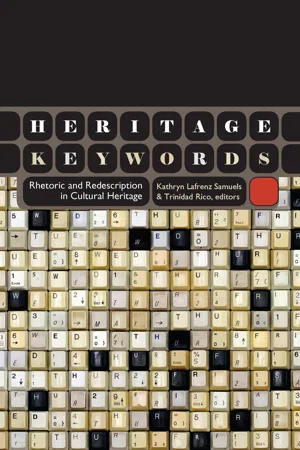
Heritage Keywords
Rhetoric and Redescription in Cultural Heritage
- English
- ePUB (mobile friendly)
- Available on iOS & Android
Heritage Keywords
Rhetoric and Redescription in Cultural Heritage
About this book
Situated at the intersection of scholarship and practice, Heritage Keywords positions cultural heritage as a transformative tool for social change. This volume unlocks the persuasive power of cultural heritage—as it shapes experiences of change and crafts present and future possibilities from historic conditions—by offering new ways forward for cultivating positive change and social justice in contemporary social debates and struggles. It draws inspiration from deliberative democratic practice, with its focus on rhetoric and redescription, to complement participatory turns in recent heritage work.
Through attention to the rhetorical edge of cultural heritage, contributors to this volume offer innovative reworkings of critical heritage categories. Each of the fifteen chapters examines a key term from the field of heritage practice—authenticity, civil society, cultural diversity, cultural property, democratization, difficult heritage, discourse, equity, intangible heritage, memory, natural heritage, place, risk, rights, and sustainability—to showcase the creative potential of cultural heritage as it becomes mobilized within a wide array of social, political, economic, and moral contexts.
This highly readable collection will be of interest to students, scholars, and professionals in heritage studies, cultural resource management, public archaeology, historic preservation, and related cultural policy fields.
Contributors include Jeffrey Adams, Sigrid Van der Auwera, Melissa F. Baird, Alexander Bauer, Malcolm A. Cooper, Anna Karlström, Paul J. Lane, Alicia Ebbitt McGill, Gabriel Moshenska, Regis Pecos, Robert Preucel, Trinidad Rico, Cecelia Rodéhn, Joshua Samuels, Kathryn Lafrenz Samuels, and Klaus Zehbe.
Frequently asked questions
- Essential is ideal for learners and professionals who enjoy exploring a wide range of subjects. Access the Essential Library with 800,000+ trusted titles and best-sellers across business, personal growth, and the humanities. Includes unlimited reading time and Standard Read Aloud voice.
- Complete: Perfect for advanced learners and researchers needing full, unrestricted access. Unlock 1.4M+ books across hundreds of subjects, including academic and specialized titles. The Complete Plan also includes advanced features like Premium Read Aloud and Research Assistant.
Please note we cannot support devices running on iOS 13 and Android 7 or earlier. Learn more about using the app.
Information
1 Introduction
Table of contents
- Cover
- Title Page
- Contents
- List of Figures
- List of Tables
- Key Acronyms
- Heritage Conventions, Guidelines, and Legal Instruments Cited
- 1 Introduction: Heritage as Persuasion
- 2 Authenticity: Rhetorics of Preservation and the Experience of the Original
- 3 Civil Society: Civil Society in the Field of Cultural Property Protection during Armed Conflict
- 4 Cultural Diversity: Cultivating Proud and Productive Citizens in Belizean Education
- 5 Cultural Property: Building Communities of Stewardship beyond Nationalism and Internationalism
- 6 Democratization: The Performance of Academic Discourse on Democratizing Museums
- 7 Difficult Heritage: Coming ‘to Terms’ with Sicily’s Fascist Past
- 8 Equity: Polestar or Pretense? International Archaeological Tourism Development in ‘Less Developed Countries’
- 9 Heritage at Risk: The Authority and Autonomy of a Dominant Preservation Framework
- 10 Heritage Discourse: The Creation, Evolution, and Destruction of Authorized Heritage Discourses within British Cultural Resource Management
- 11 Intangible Heritage: What Brain Dead Persons Can Tell Us about (Intangible) Cultural Heritage
- 12 Memory: Towards the Reclamation of a Vital Concept
- 13 Natural Heritage: Heritage Ecologies and the Rhetoric of Nature
- 14 Place: Cochiti Pueblo, Core Values, and Authorized Heritage Discourse
- 15 Rights: Heritage Rights and the Rhetoric of Reality in Pre-Revolution Tunisia
- 16 Sustainability: Primordial Conservationists, Environmental Sustainability, and the Rhetoric of Pastoralist Cultural Heritage in East Africa
- 17 After Words: A De-dichotimization in Heritage Discourse
- About the Authors
- Index